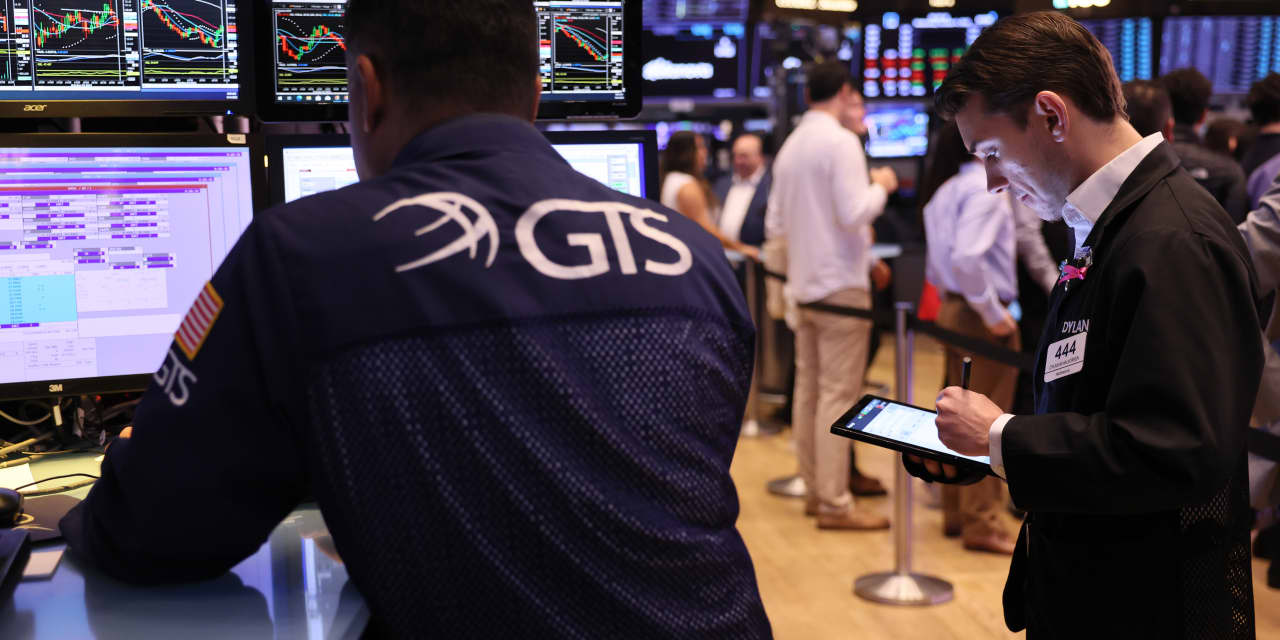A scene from the trading floor at the New York Stock Exchange. Tech stocks have led the market higher this year.
Michael M. Santiago/Getty Images
Big tech has soared this year, bringing the broader market along with it. Yet investors hoping that the good times will keep rolling should be more concerned about banks’ woes than tech’s wins.
This year has been as brutal for banks as it has been good for tech. Back in March, the financial sector was rocked by the collapses of Silvergate Bank, Silicon Valley Bank, and Signature Bank in swift succession. The demise caught nearly all investors by surprise, while the hasty merger of
UBS
(ticker: UBS) and Credit Suisse, ending the latter’s 150 year-plus run, meant that it wasn’t just regional banks caught up in the turmoil.
Some believe more regional bank failures are still ahead. Interest rates remain high, adding to the unrealized losses on banks’ balance sheets that raised fears about lenders’ soundness in March.
In response to that, and excited by the potential profits from artificial intelligence, investors have flocked to well capitalized tech stocks.
The upshot is that the
Nasdaq Composite
is the best-performing major index this year, and the
Technology Select Sector SPDR Fund
(XLK) has jumped more than 38% year to date. Bank stocks have had a very different trajectory.
The Financial Select Sector SPDR ETF (XLF) is off 2.5% year to date. The KBW Nasdaq Bank Index (KBW) has tumbled almost 24%, and has been nearly cut in half since its record high in January 2022. And the
SPDR S&P Regional Banking ETF
(KRE) is down 30% in 2023.
Friday brought some good news for the beleaguered sector.
Wells Fargo’s
(WFC) earnings were better than expected, making the stock one of the best performers in the S&P 500 for the day, while
Citigroup’s
(C) upbeat results offered hope that its turnaround is succeeding.
Yet the banking sector needs more than just a few good reports. Even
JPMorgan Chase’s
(JPM) robust third-quarter numbers simply raise the bar for peers at a time when many are struggling.
Of course, plenty of investors may feel all that doesn’t matter much, given that Big Tech shows little sign of slowing down.
The so-called Magnificent Seven—Apple (ticker: AAPL), Amazon.com (AMZN), Alphabet (GOOGL),
Meta Platforms
(META), Microsoft (MSFT), Nvidia (NVDA), and Tesla (TSLA)—account for some 28% of the
S&P 500
by market capitalization. With all but Meta and Telsa valued at well over a trillion dollars, they dwarf JPMorgan’s $436.4 billion market capitalization.
Nonetheless, as John Roque, 22V Research’s head of technical strategy, noted on Friday, history shows that banks’ slump should still worry investors.
“When have we ever had a bull market with banks in a bear market?” he asked. A look at charts going back to before the 2008-2009 financial crisis show “that corrections (at least) for the Investment Banking & Brokerage Index have, for almost two decades, preceded or coincided with corrections (at least) for the S&P 500.”
The charts also indicate that big banks’ pain isn’t necessarily over.
While
Goldman Sachs Group
stock (GS) has fallen 10% in 2023, it is below its 12-month moving average. Its so-called monthly moving average convergence/divergence, a technical measure that emphasizes recent performance, is also softening.
Roque argued that indicates the shares could break through their $300 level of support, and fall back to $250. He said that
Morgan Stanley’s
chart shows similar issues, and that the stock could drop to $60.
Goldman Sachs and Morgan Stanley were trading at $311 and $78, respectively, on Friday afternoon.
On Oct. 5, Mark Newton, FundStrat’s head of technical strategy, suggested that investors steer clear of regional banks for the moment, though he said they may finally be at least close to hitting a low after having “performed miserably” recently.
“Overall, it looks correct to await a bit more weakness into mid-October, with the knowledge that regional banks are getting closer to bottoming, technically speaking,” he wrote. The SPDR S&P Regional Banking ETF, near $41 on Friday, could fall back to $38 before finding any kind of support, he said.
All that matters because for all tech’s dominance, the financial sector isn’t a lightweight. It accounts for 12.6% of the S&P 500, making it the third-biggest of the 11 sectors, after information technology and health care.
Tech may have carried the day this year, but pushing the S&P 500 higher still would be harder if banks are sagging.
Write to Teresa Rivas at [email protected]
Read the full article here










